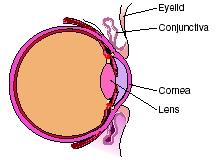Conjunctivitis - Symptoms
Symptoms of conjunctivitis can range from mild to serious. They can affect one eye or both. Some common symptoms include redness of the eye, swelling of the eyelid, and a discharge from the eye. The discharge is watery and either yellow or green in color. Some kinds of viruses cause more serious reactions. They may cause the eye to feel scratchy and have a pus-like discharge. These infections also can cause swelling and tenderness of the lymph nodes behind the ear.

Bacterial infections of the conjunctiva also cause redness of the eye and swelling of the eyelids. They may produce a pus-like discharge that turns crusty during the night. Some forms of bacteria that cause sexually transmitted diseases (see sexually transmitted diseases entry), such as gonorrhea, can also cause conjunctivitis. Infections of this kind may result in intolerance to light and tenderness in the lymph nodes behind the ear. These symptoms may last up to three months.
Some environmental conditions that cause conjunctivitis include wind, smoke, dust, pollen, and grass. As with infections, these factors can cause redness in the eye, swelling of the eyelid, and discharge from one or both eyes. Chemicals in contact lens solutions can sometimes produce similar reactions. Less common causes of conjunctivitis include exposure to sun lamps and problems with the tear ducts, the structures that produce tears for the eyes.

Comment about this article, ask questions, or add new information about this topic: